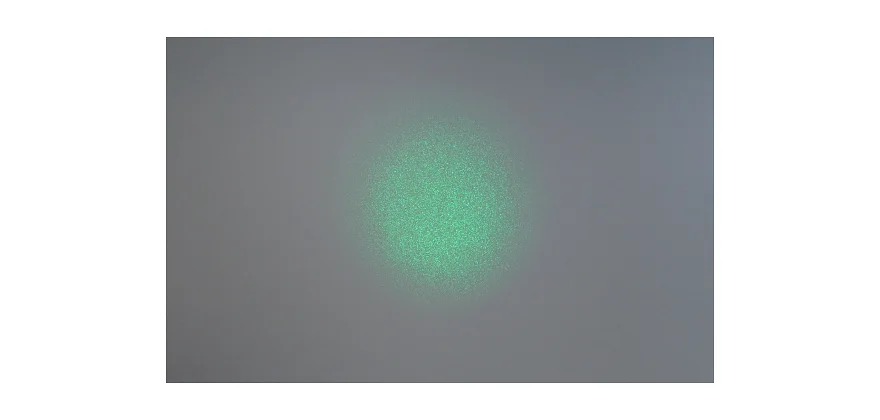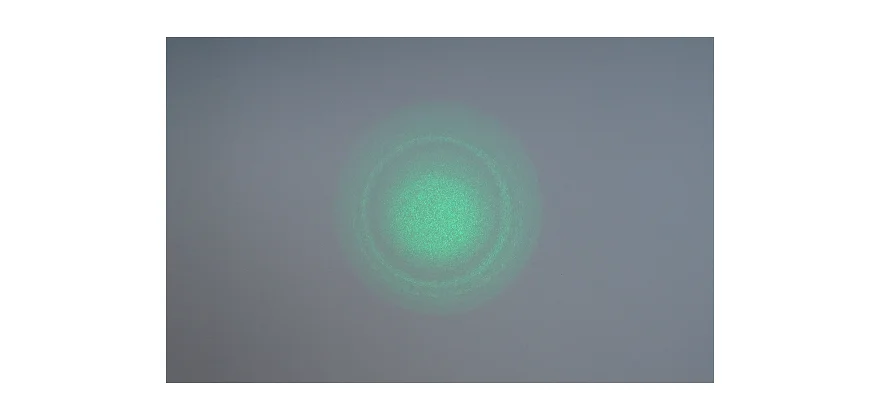Coupling into multimode fibers
Selection of coupling focal length for a circular beam emitted by a point source
When using a multimode fiber, the coupling focal length is calculated from the beam diameter and the nominal fiber NA
{!{!{f\prime=\frac{0.5\cdot\emptyset_{beam}}{NA}}!}!}Effects of mode mixing on the beam profile of a fiber coupled multimode fiber
The beam profile exiting a multimode fiber is strongly dependent on how the light interacts within the fiber and is often very different from that of a single-mode fiber - it might even change with time and fiber position. For a good, symmetric, and “super-Gaussian” distribution of light exiting the multimode fiber (aside from laser speckle), it is important that mode mixing has occurred within the fiber or that multiple modes have been excited from the start when coupling in.
For example, if you couple light into the fiber from a single-mode laser source, only a few modes will be excited. If you then change the fiber position or touch the fiber, the ex-fiber beam profile can change rapidly over time because different modes are excited that may not have a symmetric, Gaussian-like output (e.g. donut modes).
To avoid this, you can either make the multimode fiber longer (to increase mode mixing as it passes through the fiber) or coil the fiber with a smaller bend radius to increase mode mixing. You can also choose a smaller focal length to have a larger light cone when coupling into the fiber, which in turn excites more modes. Often a combination of these three strategies will result in a stable, “super-Gaussian” beam profile exiting the multimode fiber.

Beam profile with sufficient mode mixing
Stable beam profile exiting a multimode fiber with "super" Gaussian beam profile.

Multimode beam profile with bad beam profile
Insufficient mode mixing leads to an unstable beam profile, that might have ring structures and can change over time or when the fiber is touched or positioned differently.
Coupling an Extended Source Into a Multimode Fiber
The Beam Parameter Product (BPM) of an extended light source
When coupling the radiation of an extended source into a multimode fiber, there are principle limitations.
An extended source, e.g. a LED source or a plasma typically emits a beam from a large area and with a large angular spectrum. This beam characteristics (area x angle) is given by the so-called beam parameter product BPM or, more precisely, the étendue.
The multimode fiber however, (as every fiber type), only has a limited acceptance angle and core area (defined by the numerical aperture and the core diameter, respectively). Only light that is focused with the right angle (-> numerical aperture) and focus size (-> core diameter) is coupled into the fiber, everything else is not transmitted. The multimode fiber accepts beams with the corresponding BPM.
Every components has different BPMs it emits or accepts (source, optics, as well as fiber). In classical optics, this BPM is an invariant, which means that it is not possible to change the BPM of an optical system by means of optical imaging.
An extended source , e.g. a LED source or a plasma emits a beam that automatically has a large BPM as both the emitter area as well as the angular spectrum is large. This also means that you need to choose a fiber that accepts a large BPM (large NA, large core diameter) in order to couple as much light as possible into the fiber.
So how do I choose the right coupling optic?
Note: Single-mode fibers have a smaller NA and a smaller MFD. Maximum coupling efficiency is achieved for an ideal Gaussian beam (M2 = 1, no astigmatism) when the convergence of the focused, circular beam equals the effective NAe2 of the fiber. Then the laser spot on the fiber end face equals the mode field diameter MFD of the single mode fiber. Thus single-mode fibers accept a much smaller BPM compared to multimode fibers.
It is impossible to couple a significant amount of light emitted by an extended source into a single-mode fiber.